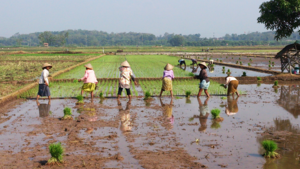Leptospirosis facts for kids
Quick facts for kids Leptospirosis |
|
|---|---|
| Synonyms | Rat fever, field fever, rat catcher's yellows, pretibial fever |
 |
|
| Leptospira magnified 200-fold with a dark-field microscope | |
| Symptoms | None, headaches, muscle pains, fevers |
| Complications | Bleeding from the lungs, meningitis, kidney failure |
| Usual onset | One to two weeks |
| Causes | Leptospira typically spread by rodents |
| Risk factors | Exposure to infected animals, especially their urine, or fresh water or damp soil contaminated with infectious urine |
| Diagnostic method | Testing blood for antibodies against the bacterium or its DNA |
| Similar conditions | Malaria, enteric fever, rickettsiosis, dengue |
| Prevention | Personal protective equipment, hygiene measures, doxycycline |
| Treatment | Doxycycline, penicillin, ceftriaxone |
| Prognosis | Risk of death ~7.5% |
| Frequency | One million people per year |
| Deaths | 58,900 per year |
Leptospirosis is a blood infection caused by tiny living things called Leptospira bacteria. These bacteria can infect humans, dogs, rodents, and many other wild and farm animals. Sometimes, people who get leptospirosis don't feel sick at all. Others might have mild symptoms like headaches, muscle pains, and fevers. In more serious cases, it can cause problems like bleeding in the lungs or an infection of the brain and spinal cord called meningitis.
A very serious form of leptospirosis is called Weil's disease. When someone has Weil's disease, their skin and eyes can turn yellow (this is called jaundice). They might also have kidney failure and bleeding problems. If the bleeding happens in the lungs, it's known as severe pulmonary haemorrhage syndrome.
Contents
How Leptospirosis Spreads
More than ten different types of Leptospira bacteria can make humans sick. Both wild animals, like rodents, and farm animals can carry and spread these bacteria. The bacteria usually spread to humans through animal urine or water and soil that have been touched by infected animal urine. If this contaminated water or soil gets into your eyes, mouth, nose, or any cuts on your skin, you can get infected.
Who is at Risk?
In many parts of the world, especially poorer countries, leptospirosis is common. It often affects people who work with pests, farmers, or those living in areas with poor sanitation. In richer countries, it can happen after heavy rain. People who work with sewage, control pests, or enjoy outdoor activities in warm, wet places are also at risk.
How Doctors Find and Treat It
Doctors usually find leptospirosis by testing your blood. They look for special fighters called antibodies that your body makes against the bacteria. They can also look for the bacteria's DNA in your blood.
Preventing Leptospirosis
There are ways to avoid getting sick.
- Wear protective gear like gloves and boots if you work with animals or in wet, muddy areas.
- Always wash your hands well after touching animals or working in places where animals might have been.
- Try to keep rodents away from where people live and work.
- A medicine called doxycycline can help prevent infection if you know you'll be in a risky situation.
- There are some vaccines for humans, but they don't work for all types of the bacteria. Vaccines for animals are more common and helpful.
Treating the Infection
If someone gets leptospirosis, doctors can treat it with antibiotics. Common antibiotics used are doxycycline, penicillin, or ceftriaxone.
How Serious is Leptospirosis?
About one million people get a severe form of leptospirosis each year around the world. Sadly, about 58,900 people die from it every year. The risk of dying from leptospirosis is usually about 5% to 10%. However, if the infection causes serious bleeding in the lungs, the risk of death can go up to 50% or even 70%.
Where is it Most Common?
Leptospirosis is most common in tropical parts of the world. But it can happen anywhere. Sometimes, many people get sick at once (an epidemic) after heavy rainfall.
History of Leptospirosis
The disease was first described in 1886 by a doctor named Adolf Weil in Germany. This is why the severe form is sometimes called Weil's disease.
Leptospirosis in Animals
Animals that are infected with Leptospira might not show any signs of being sick, or they might have mild or severe symptoms. The symptoms can be different depending on the type of animal. In some animals, the bacteria can live in their reproductive system. This means they can pass the infection to other animals when they mate.
Images for kids




